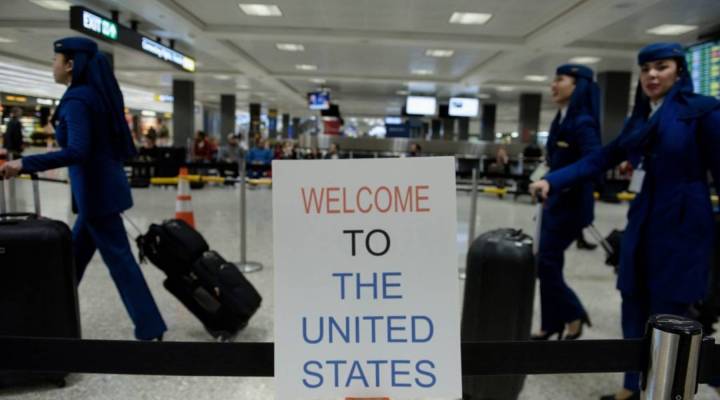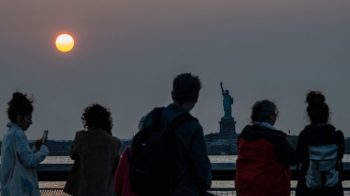
New signs of slowdown in foreign travel to the US

One of the spots tourists flock to in New York City is Grand Central Station. You’ll often find them in the Main Concourse, craning their necks to look at the green ceiling dotted with tiny golden stars or standing on the marble staircase looking down as hundreds of New Yorkers run to catch their trains.
That’s where where Luis Bechara, 29, and Vitor Saiki, 30, from Brazil were taking selfies one recent night during rush hour.
Bechara said they flew to the United States on a Mexican airline. Having heard President Trump’s stance on Mexico and his call for tighter immigration rules, they were a little worried. “We don’t know how people in the immigration center will receive us,” Bechara said. “But it was OK. They made some questions, but it was normal.”
They’re glad they came, he said, but it looks like some people may not take that chance.
Tourism Economics, a travel research firm, has revised its forecast for overseas visitors to the United States in 2017 after years of growth. The firm expects the number of international travelers to fall by nearly 2 million, and it estimates that the drop will cost businesses $2.5 billion.
- RELATED: Uncertainty over Trump’s travel ban is a cloud for the industry, Expedia CEO says
- Trump’s travel ban worries international students
- Iraqis are relieved to be excluded from new travel ban
The latest data show that flight bookings, travel searches and other indicators of interest in U.S. travel have dropped, said Adam Sacks, president of Tourism Economics. “All of these together are painting this picture of a shift in travel patterns away from the U.S.,” he said.
The strong U.S. dollar is one potential reason for slowing interest in international travel to the U.S. But Sacks said the political environment is a bigger issue. Based on his research, he attributes the drop to Trump’s America-first rhetoric: his talk about a border wall with Mexico, the travel ban, the notion of extreme vetting.
“It conveys a position of unwelcoming,” he said. “And so that’s affecting potential travelers.”

Vitor Saiki, 30, and Luis Bechara, 29, from Brazil, are visiting New York.
Some of those travelers are worried they’ll pay for airfare, hotels and everything else, and then they won’t be allowed into the country.
Nicolai Chen Nielsen, a 30-year-old Brazilian-Danish citizen working as a consultant for McKinsey in Dubai, said he and his wife were planning to visit friends in the U.S. this summer. “We had all the dates planned,” Nielsen said.
But Nielsen’s wife is a Swedish-Iranian citizen, and with the travel ban, they don’t know if they’ll be allowed in. He said a round-trip ticket from Dubai could cost $1,500.
“The whole notion of, you know, locking dates, planning a summer holiday and getting that cancelled, that’s the biggest impediment for me,” he said. “Then I’d rather use the week visiting friends somewhere else in Europe or visiting my family in Denmark.”
Other travelers are staying home as a form of protest.
Grant Hayter-Menzies, a 52-year-old Canadian-American citizen and an author, had been planning a book tour through the U.S. From his apartment in Vancouver, British Columbia, he said he cancelled the trip. “I couldn’t do it,” Hayter-Menzies said. “I couldn’t envision going across the border when my Muslim friends can’t.”
Cities like New York, which brought in 12.7 million international visitors last year, are taking any potential drop in tourism seriously. Right now, New York City is expecting 300,000 fewer foreign travelers in 2017 and estimates that’ll cost about $600 million in lost sales.
“Every day, people are making decisions about where they’re going to go, and if they choose to not pick New York for their 2017 holiday, you know, we’ll have to wait and try to get them again next year,” said Fred Dixon, CEO of the city’s tourism marketing agency, NYC & Co.
NYC & Co. is rolling out what it calls the “New York City: Welcoming the World,” marketing campaign in the United Kingdom, Mexico, Germany and other countries. “It was very important for us to remind people that if you do come to New York, you’re going to have a great time,” Dixon said.
First, the city will have to convince people to come.
There’s a lot happening in the world. Through it all, Marketplace is here for you.
You rely on Marketplace to break down the world’s events and tell you how it affects you in a fact-based, approachable way. We rely on your financial support to keep making that possible.
Your donation today powers the independent journalism that you rely on. For just $5/month, you can help sustain Marketplace so we can keep reporting on the things that matter to you.


















